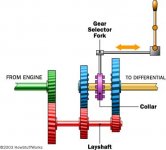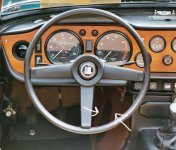[ QUOTE ]
Webb,
You don't heel toe on an upshift, you double clutch. Now, I don't know why you would do that on a tranny with synchros like they did in Bullit, or why Steve was tought to do so in cop school.
[/ QUOTE ]
But still there is no need for even that on any gearbox, whether dogbox (syncho-less, or standard). You probably are familiar with the way a gear box works, but I'll explain anyway. There is the input shaft (coming from the engine), the layshaft, and output shaft (going to the differential). There are gears on all three shafts (only 1 gear on the input), but they are only permantently connected to the input and layshafts. The ones of the layshaft can spin at the speed of the input when in neutral. The way gears are selected is that the shifter fork moves a cog gear, which engages into the side of the gears on the input shaft. While the gears on the input aren't solid against the shaft, the cog gear is and will turn at whatever speed the engine is turning. So when you go to upshift, you will already be rolling (meaning the layshaft and input gears will be spinning, from the engine), and the wheels will already be turning over (the cog gear will be spinning), so both are turning, and both will engage at a low gear speed, which is what you want because of the lower gear ratio. Double clutching would be pointless on an upshift, as it would speed up the cog gear needlessly, and actually put more strain on the synchros to slow it back down again. For a picture (which always helps me understand stuff), check out my attachment.

 Hi Guest!
Hi Guest!

 smilie in place of the real @
smilie in place of the real @
 Pretty Please - add it to our Events forum(s) and add to the calendar! >>
Pretty Please - add it to our Events forum(s) and add to the calendar! >> 


